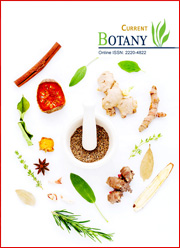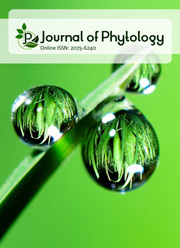Comprehensive analysis of nutritional and antioxidant properties of Cucumis callosus peel
DOI:
https://doi.org/10.25081/cb.2025.v16.9515Keywords:
Antioxidant, Cucumis callosus, Functional Properties, Phenolic Content, Proximate AnalysisAbstract
Cucumis callosus (commonly known as Kacheri) fruit is typically analyzed for its nutritional components, including moisture, ash, protein, fat, fibre, and carbohydrates. However, specific studies on C. callosus remain limited. Peel of C. callosus is a rich source of nutrients and analyzing the bioactive composition reveals its potential benefits. It constitutes about 20% of the total residue and is often considered an environmental challenge due to disposal issues. In this study, the phytochemical and proximate compositions of C. callosus peels were analyzed. The proximate analysis revealed a fat content of 6.89%, protein content of 9.34%, moisture content of 9.59%, ash content of 8.18%, and carbohydrate content of 36.66%. The crude fibre in the peels was found to be 29.34±0.94%. The crude fibre C. callosus content of peels was significantly higher compared to other vegetable peels. C. callosus has demonstrated remarkable functional properties, exhibiting a water-holding capacity 26 times its own weight and an oil-holding capacity 16 times its own weight. The methanolic extract of C. callosus peel exhibited antioxidant activity with an IC50 value of 67.76±2.34 μg/mL in the DPPH assay, indicating its potential as a promising natural antioxidant source. The mineral analysis result shows Iron as a major element followed by zinc and copper, and manganese highlighting their potential nutritional benefits. This study aims to raise awareness about the potential of C. callosus peels as a valuable source of phenolic compounds and iron element. The research underscores the importance of utilizing these peels in various food products to enhance their nutritional and technological properties.
Downloads
References
AOAC. (2005). Official Methods of Analysis. (18th ed.). Maryland, USA: AOAC International.
Bhardwaj, K., Najda, A., Sharma, R., Nurzyńska-Wierdak R., Dhanjal D. S., Sharma R., Manickam S., Kabra, A., Kuča, K., & Bhardwaj, P. (2022). Fruit and vegetable peel-enriched functional foods: potential avenues and health perspectives. Evidence-Based Complementary and Alternative Medicine, 2022(1), 8543881. https://doi.org/10.1155/2022/8543881
Biswas, S., Ghosh, P., Dutta, A., Biswas, M., & Chatterjee, S. (2021). Comparative analysis of nutritional constituents, antioxidant and antimicrobial activities of some common vegetable wastes. Current Research in Nutrition and Food Science Journal, 9(1), 62-74. https://doi.org/10.12944/CRNFSJ.9.1.07
Brand-Williams, W., Cuvelier, M. E., & Berset, C. (1995). Use of a free radical method to evaluate antioxidant activity. LWT - Food Science and Technology, 28(1), 25-30. https://doi.org/10.1016/S0023-6438(95)80008-5
Chand, T., Bhandari, A., Kumawat, B. K., Basniwal, P. K., Sharma, S., & Verma, R. (2012). In vitro antioxidant activity of alcoholic extract of seeds of Cucumis callosus (Rottl.) Cogn. American Journal of PharmTech Research, 2(3), 2249-3387.
Chang, C.-C., Yang, M.-H., Wen, H.-M., & Chern, J.-C. (2002). Estimation of total flavonoid content in propolis by two complementary colorimetric methods. Journal of Food and Drug Analysis, 10(3), 178-182. https://doi.org/10.38212/2224-6614.2748
Chantaro, P., Devahastin, S., & Chiewchan, N. (2008). Production of antioxidant high dietary fiber powder from carrot peels. LWT - Food Science and Technology, 41(10), 1987-1994. https://doi.org/10.1016/J.LWT.2007.11.013
Coman, V., Teleky B.-E., Mitrea, L., Martău, G. A., Szabo, K., Călinoiu, L.-F., & Vodnar, D. C. (2020). Bioactive potential of fruit and vegetable wastes. Advances in Food and Nutrition Research, 91, 157-225. https://doi.org/10.1016/bs.afnr.2019.07.001
Dahot, M. U., Mangrio, S. M., Khaskhely, M. H., & Dewani, V. K. (1999). Nutrient composition of chibber fruit. Communications in Soil Science and Plant Analysis, 30(1-2), 75-82. https://doi.org/10.1080/00103629909370185
Das, A. K., Nanda, P. K., Chowdhury, N. R., Dandapat, P., Gagaoua, M., Chauhan, P., Pateiro, M., & Lorenzo, J. M. (2021). Application of pomegranate by-products in muscle foods: oxidative indices, colour stability, shelf life and health benefits. Molecules, 26(2), 467. https://doi.org/10.3390/molecules26020467
Deepika, Kumari, A., Prajapati, P., Sarita, Kumar, S., Aluko, R. E., Singh, S., & Garg, M. (2023). Pharmacological and therapeutic potential of Cucumis callosus: a novel nutritional powerhouse for the management of non-communicable diseases. Plant Foods for Human Nutrition, 78, 630-642. https://doi.org/10.1007/s11130-023-01098-y
Devi, T., & Geethanjali, S. (2017). Development and evaluation of ridge gourd peel incorporated pasta. International Journal of Home Science, 3(3), 199-202.
Ediriweera, E. R. H. S. S., & Ratnasooriya, W. D. (2009). A review on herbs used in treatment of diabetes Mellitus by Sri Lankan ayurvedic and traditional physicians. Journal Ayu, 30(4), 373-391.
Goyal, M., & Sharma, S. K. (2009). Traditional wisdom and value addition prospects of arid food of desert region of North West India. Indian Journal of Traditional Knowledge, 8(4), 581-585.
Gullón, P., Astray, G., Gullón, B., Tomasevic, I., & Lorenzo, J. M. (2020). Pomegranate peel as suitable source of high-added value bioactives: tailored functionalized meat products. Molecules, 25(12), 2859. https://doi.org/10.3390/molecules25122859
Hussain, T., Kalhoro, D. H., & Yin, Y. (2023). Identification of nutritional composition and antioxidant activities of fruit peels as a potential source of nutraceuticals. Frontiers in Nutrition, 9, 1065698. https://doi.org/10.3389/fnut.2022.1065698
Jeddou, K. B., Châari, F., Maktouf, S., Nouri-Ellouz, O., Helbert, C. B., & Ghorbel, R. E. (2016). Structural, functional, and antioxidant properties of water-soluble polysaccharides from potatoes peels. Food Chemistry, 205, 97-105. https://doi.org/10.1016/j.foodchem.2016.02.108
Jimenez-Champi, D., Romero-Orejon, F. L., Moran-Reyes, A., Muñoz, A. M., & Ramos-Escudero, F. (2023). Bioactive compounds in potato peels, extraction methods, and their applications in the food industry: a review, CyTA - Journal of Food, 21(1), 418-432. https://doi.org/10.1080/19476337.2023.2213746
Kirtikar, K. R., & Basu, B. D. (1935). Indian Medicinal Plants. (Vol. 2). Allahabad, India: Lalit Mohan Publication.
Larrauri, J. A., Ruperez, P., Borroto, B., & Saura-Calixto, F. (1996). Mango peels as a new tropical fibre: Preparation and Characterization. LWT - Food Science and Technology, 29(8), 729-733. https://doi.org/10.1006/fstl.1996.0113
Ma, M., & Mu, T. (2016). Effects of extraction methods and particle size distribution on the structural, physicochemical, and functional properties of dietary fiber from deoiled cumin, Food Chemistry, 194, 237-246. https://doi.org/10.1016/j.foodchem.2015.07.095
Martínez, R., Torres, P., Meneses, M. A., Figueroa, J. G., Pérez-Álvarez, J. A., & Viuda-Martos, M. (2012). Chemical, technological and in vitro antioxidant properties of mango, guava, pineapple and passion fruit dietary fibre concentrate. Food Chemistry, 135(3), 1520-1526. https://doi.org/10.1016/j.foodchem.2012.05.057
Meena, S. R., Singh. R. S., Sharma, B. D., & Singh, D. (2016). Most favourite traditional cucurbitaceous vegetables and their utilization pattern in Thar desert of the western Rajasthan. Indian Journal of Traditional Knowledge, 15(3), 385-394.
Olufunso, A. B., Comfort, B. D., Elízabeth, A. F., Olubukola, A. O., Celine, A. H., Temitope, A. B., Chibundo, O. C., Onyinyechi, A. S., Bimbola, A.-A. F., Ikenna, E. I., Olajoju, O. M., Bangsi, A. C., Chinasa, N. J., David, A. A., Phillips, A. O., Adebola, A. O., & Olajumoke, A.-B. G. (2024). Peels of edible plants as treasure trove of remarkable nutraceutical properties: Prospects for medical nutrition therapy. EAS Journal of Nutrition and Food Sciences, 6(6), 184-196. https://doi.org/10.36349/easjnfs.2024.v06i06.005
Onyeike, E. N., Olungwe, T., & Uwakwe, A. A. (1995). Effect of heat-treatment and defatting on the proximate composition of some Nigerian local soup thickeners. Food Chemistry, 53(2), 173-175. https://doi.org/10.1016/0308-8146(95)90784-5
Rahman, A. H. M. M., Anisuzzaman, M., Alam, M. Z., Islam, A. K. M. R., Zaman, A. T. M. N. (2006). Taxonomic studies of the cucurbits grown in the Northern Parts of Bangladesh. Research Journal of Agriculture and Biological Sciences, 2(6), 299-302.
Sadef, Y., Javed, T., Javed, R., Mahmood, A., Alwahibi, M. S., Elshikh, M. S., AbdelGawwa, M. R., Alhaji, J. H., & Rasheed, R. A. (2022). Nutritional status, antioxidant activity and total phenolic content of different fruits and vegetables’ peels. PLoS One, 17(5), e0265566. https://doi.org/10.1371/journal.pone.0265566
Sadiyah, E. R., Purwanti, L., Hazar, S., Sasmita, S. O., & Yuniarti, A. (2020). Total polyphenol and flavonoid content comparison of Kertasari Arabica coffee (Coffea arabica L.) leaves, pulp, and beans. In A. G. Abdullah, I. Widiaty & C. U. Abdullah (Eds.), Medical Technology and Environmental Health (1st ed.). Florida, US: CRC Press. https://doi.org/10.1201/9781003016700
Seliya, A. R., & Patel, N. K. (2009). Ethnomedical uses of climbers from Saraswati River Region of Patan District, North Gujarat. Ethnobotanical Leaflets, 13, 865-872.
Singh, J., Kaur, H. P., Verma, A., Chahal, A. S., Jajoria, K., Rasane, P., Kaur, S., Kaur, J., Gunjal, M., Ercisli, S., Choudhary, R., Bozhuyuk, M. R., Sakar, E., Karatas, N., & Durul, M. S. (2023). Pomegranate peel phytochemistry, pharmacological properties, methods of extraction, and its application: A comprehensive review. ACS Omega, 8(39), 35452-35469. https://doi.org/10.1021/acsomega.3c02586
Suhag, R., Kumar, R., Dhiman, A., Sharma, A., Prabhakar, P. K., Gopalakrishnan, K., Kumar, R., & Singh, A. (2022). Fruit peel bioactives, valorisation into nanoparticles and potential applications: a review. Critical Reviews in Food Science and Nutrition, 63(24), 6757-6776. https://doi.org/10.1080/10408398.2022.2043237
Sultana, B., Hussain, Z., Asif, M., & Munir, A. (2012). Investigation on the antioxidant activity of leaves, peels, stems bark, and kernel of mango (Mangifera indica L.). Journal of Food Science, 77(8), C849-C852. https://doi.org/10.1111/j.1750-3841.2012.02807.x
Susmi, T. F., Khan, M. R., Hasan, N., Aktar, A., & Amin, M. Z. (2023). Bioactivity profiling of native and hybrid varieties of pumpkin peel (Cucurbita maxima Linn.). Journal of Agriculture and Food Research, 14, 100813. https://doi.org/10.1016/j.jafr.2023.100813
Taglieri, I., Sanmartin, C., Venturi, F., Macaluso, M., Bianchi, A., Sgherri, C., Quartacci, M. F., De Leo, M., Pistelli, L., Palla, F., Flamini, G., & Zinnai, A. (2021). Bread fortified with cooked purple potato flour and Citrus Albedo: An evaluation of its compositional and sensorial properties. Foods, 10(5), 942. https://doi.org/10.3390/foods10050942
Varadharajan, R., Rajalingam, D., & Palani S. (2016). GCMS/MS analysis and cardioprotective potential of cucumis callosus on doxorubicin-induced cardiotoxicity in rats. International Journal of Pharmacy and Pharmaceutical Sciences, 8(9), 239-245. https://doi.org/10.22159/ijpps.2016.v8i9.13292
Wanderley, R. de O. S., de Figueirêdo, R. M. F., de Melo Queiroz, A. J., dos Santos, F. S., Paiva, Y. F., de Lima Ferreira, J. P., de Lima, A. G. B., Gomes, J. P., Costa, C. C., da Silva, W. P., da Costa Santos, D., & Maracajá, P. B. (2023). The temperature influence on drying kinetics and physico-chemical properties of pomegranate peels and seeds. Foods, 12(2), 286. https://doi.org/10.3390/foods12020286
Yadav, J. P., Grishina, M., Shahbaaz, M., Mukerjee, A., Singh, S. K., & Pathak, P. (2022). Cucumis melo var. momordica as a potent antidiabetic, antioxidant and possible anticovid alternative: Investigation through experimental and computational methods. Chemistry & Biodiversity, 19(9), e202200200. https://doi.org/10.1002/cbdv.202200200
Published
How to Cite
Issue
Section
Copyright (c) 2025 Priyanka Chaudhary, Kalpana Gupta

This work is licensed under a Creative Commons Attribution-NonCommercial 3.0 Unported License.



 .
.